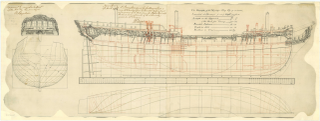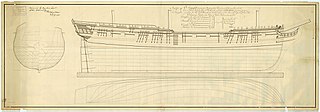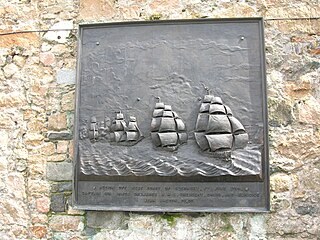American War of Independence
Sprightly shared with the frigate Amphitrite, sloop Fairy, and the cutters Griffin, Flying Fish, and Wells, in the capture on 24 May 1779 of the French privateers Dunkerque and Prince de Robcq, which had "eight ransomers" aboard. [2]
Sprightly was one of the vessels that shared in the award to the squadron of £15,000 for her role in the Affair of Fielding and Bylandt. [3] This was a brief naval engagement off the Isle of Wight on 31 December 1779 between a Royal Navy squadron under the command of Commodore Charles Fielding, and a naval squadron of the Dutch Republic under the command of Rear-admiral Lodewijk van Bylandt, which was escorting a Dutch convoy.
On 27 March 1780, Sprightly, under the command of Lieutenant Gabriel Bray, and another cutter, Resolution captured the cutter Larke. [4]
Next, Sprightly, Resolution, and the tender Union captured the brig Susanna on 8 April. [5]
On 25 December 1780, Sprightly was in company with the sloop Fortune. She therefore shared in the proceeds of the capture on that day of Noord Star. [6]
Sprightly, was among the vessels that shared in the proceeds of the capture of the Dutch warship Princess Caroline on 30 December. [7]
Around 2 January 1781 the cutters Sprightly, Repulse, and Expedition brought several captured Dutch vessels into The Downs. [8]
French Revolutionary Wars
On 23 March 1794 Sprightly put into the Scilly Islands, together with a convoy of some 200 merchant vessels and their other escorts. [9]
In October 1794 Lieutenant Robert Jump assumed command of Sprightly.
Sprightly was either at Plymouth, or assigned to the port on 20 January 1795. Consequently, she shared in the prize money for the Dutch warships, East Indiamen, and merchant vessels that were there too and that the British seized. [10]
On 3 July 1795 Melampus and Hebe intercepted a convoy of 13 vessels off St Malo. Melampus captured an armed brig and Hebe captured six merchant vessels. The brig of war was armed with four 24-pounders and had a crew of 60 men. Later she was identified as the 4-gun Vésuve. One of the merchant vessels was Abeille. The convoy had been on its way from Île-de-Bréhat to Brest. [11] Seaflower, Daphne and Sprightly shared in the prize and head money. [12]
Sprightly arrived at Plymouth on 23 March 1797. Two days earlier she had encountered two French privateers, one of 14 guns and one of six, and engaged them for an hour. Apparently both sides disengaged. The French had with them three British brigs that they had captured. [13]
In January 1799 Jump sailed Sprightly for Jamaica. Later that year Sprightly and the brig Spitfire captured the brig Gute Hoffnung. [14] At some point between 6 May 1799 and 1 June 1799, Sprightly captured the French schooner Esperance, of six guns and 22 men. Esperance had been carrying a cargo of sugar and coffee from Cap François to St Thomas. [15] At some point between 28 February and 20 May 1800, Sprighlty was on the Spanish Main where she captured a Spanish brig loaded with fustic. [16]
Jump and Sprightly arrived at Plymouth from Jamaica on 19 September 1800. They brought mails and passengers and had taken only 45 days for the voyage.
Fate
On 20 January 1801, Sprightly left Plymouth, as did a number of other cutters, under orders to stop all Danish, Swedish, and Russian vessels. [17]
Next, Sprightly was on her way to Gibraltar with dispatches when she had the misfortune to encounter a French squadron under Admiral Ganteaume about 40 miles south-west of Cape de Gata. During one of his expeditions, Ganteaume had called his squadron to a halt there. After a two-hour chase, Sprightly struck to the 74-gun Dix-août on 10 February 1801. The French scuttled their prey.
On 26 February two French brigs arrived at Plymouth carrying wine and brandy. Sprightly and Incendiary had captured them before falling prey to Ganteaume. [19]
On her way back from Rhodes the hired armed lugger Speedwell stopped at Mahón. There she took on board as a passenger Lieutenant Jump, whom she carried to Plymouth. [20] Jump underwent a court martial on 6 May aboard HMS Gladiator for the loss of his vessel and was acquitted. [21]

HMS Galatea was a fifth-rate 32-gun sailing frigate of the British Royal Navy that George Parsons built at Bursledon and launched in 1794. Before she was broken up in 1809 she captured numerous prizes and participated in a number of actions, first in the Channel and off Ireland (1794–1803), and then in the Caribbean (1802–1809), including one that earned her crew the Naval General Service Medal.
HMS Boadicea was a frigate of the Royal Navy. She served in the Channel and in the East Indies during which service she captured many prizes. She participated in one action for which the Admiralty awarded the Naval General Service Medal. She was broken up in 1858.

HMS Fly was a Swan class ship sloop of the Royal Navy and was launched on 14 September 1776. She performed mainly convoy escort duties during the French Revolutionary Wars, though she did capture three privateers. She foundered and was lost with all hands early in 1802.

HMS Unicorn was a 32-gun fifth-rate Pallas-class frigate of the Royal Navy, launched in 1794 at Chatham. This frigate served in both the French Revolutionary Wars and the Napoleonic Wars, including a medal action early in her career. She was broken up in 1815.

HMS Spitfire was a Tisiphone-class fireship of the Royal Navy. She served during the years of peace following the end of the American War of Independence, and by the outbreak of the French Revolutionary Wars, had been reclassified as a 14-gun sloop-of-war. Spitfire went on to serve under a number of notable commanders during a successful career that saw her capture a considerable number of French privateers and small naval vessels. She spent most of her career in Home waters, though during the later part of her life she sailed further afield, to the British stations in North America and West Africa. She survived the Napoleonic Wars and was eventually sold in 1825 after a period spent laid up.
HMS Atalante was a 16-gun brig-sloop of the Royal Navy. She was formerly the French Atalante, captured in 1797. She served with the British during the French Revolutionary and Napoleonic Wars, and was wrecked in 1807.
The hired armed cutter Black Joke was a cutter that served the Royal Navy from 12 January 1795 to 19 October 1801. In 1799 she was renamed Suworow, and under that name she captured numerous prizes before she was paid off after the Treaty of Amiens.
His Majesty's Hired armed cutter Lurcher was a 12-gun cutter that served the Royal Navy from 15 August 1795 until 15 January 1801 when a French privateer captured her in the Channel.
HMS Moucheron was a French privateer, built in 1799, that the British captured in 1801 and that the British government purchased in 1802 for the Royal Navy. She foundered in 1807 in the Mediterranean without leaving a trace.
HMS Incendiary was an 8-gun fireship of the Royal Navy. She was present at a number of major battles during the French Revolutionary Wars, and captured, or participated in the capture, of several armed vessels. In January 1801 she was in the Gulf of Cadiz where she encountered Admiral Ganteume's squadron. The 80-gun French Navy ship of the line Indivisible received the credit for the actual capture.

HMS Greyhound was a cutter that the British Admiralty purchased in 1780 and renamed Viper in 1781. Viper captured several French privateers in the waters around Great Britain, and took part in a notable engagement. She was sold in October 1809.
During the French Revolutionary and Napoleonic WarsThe British Royal Navy employed at least two cutters designated His Majesty's hired armedcutterNile.
Mutin was a 14-gun cutter of the French Navy, the lead ship of the Mutin class of five naval cutters. She was launched in 1778 and the Royal Navy captured her the next year, taking her into service as HMS Mutine. The Royal Navy renamed her HMS Pigmy in 1798. She was lost in 1805.

His Majesty's hired armed lugger Valiant served the Royal Navy on a contract from 5 May 1794 to 10 November 1801. She was of 109 90⁄94 tons (bm), and was armed with eleven 3-pounder guns.

The Dutch ship sloop Havik was launched in 1784 and served in the Batavian Navy. The British captured her in 1796 at the capitulation of Saldanha Bay. She then served briefly in the Royal Navy as HMS Havick before she was wrecked in late 1800.

HMS Seagull, was a Royal Navy Diligence-class brig-sloop, launched in 1795. During the French Revolutionary Wars she shared in the capture of a number of small French and Dutch privateers. Then early in the Napoleonic Wars she participated in a notable single-ship action before she disappeared without a trace in 1805.
Two vessels have borne the designation, His Majesty's hired armed cutter Constitution. The first served the British Royal Navy during the French Revolutionary Wars. The second served briefly at the start of the Napoleonic Wars and was sunk in 1804. The two cutters are similar enough that may have been the same vessel; at this juncture it is impossible to know.

The French brig Suffisante was launched in 1793 for the French Navy. In 1795 the Royal Navy captured her and took her into service under her existing name. HMS Suffisante captured seven privateers during her career, as well as recapturing some British merchantmen and capturing a number of prizes, some of them valuable. She was lost in December 1803 when she grounded in poor weather in Cork harbour.
His Majesty's Hired armed lugger Speedwell served the Royal Navy on contract between 11 June 1796 and 31 October 1801. She had a burthen of 15215⁄94 tons (bm), and was armed with fourteen 4-pounder guns.
HMS Pilote was a cutter launched for the French Navy at Dunkirk in 1778. The British Royal Navy captured her in 1779 and took her into service under her existing name. It sold her in 1799.
This page is based on this
Wikipedia article Text is available under the
CC BY-SA 4.0 license; additional terms may apply.
Images, videos and audio are available under their respective licenses.









